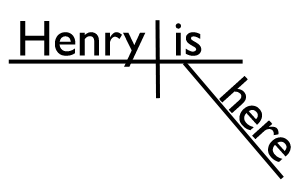Is isn't always a linking verb.
Is isn't always a linking verb.
- Home
- Parts of Speech
- Verbs
- "Is" Linking Verb?
"Is" is a linking verb.
That seems to be a commandment of grammar that was drilled into people's minds by every well-meaning teacher.
The problem is that it's not entirely accurate. It would be more accurate to say that is can be a linking verb or that is often acts as a linking verb.
The truth is that is can also be a helping verb or an intransitive complete verb. ("Intransitive complete verb" sounds scary, but don't get intimidated. I pinky swear that it's not too complicated. I'll teach you about it below.)
1. Henry is happy. (is = intransitive linking verb)
2. Henry is walking. (is = helping verb)
3. Henry is here. (is = intransitive complete verb)
In this lesson, you'll learn about the verb is as we go over each of those example sentences.
Psst! This lesson applies to other forms of to be (am, are, was, were) as well.

1. Henry is happy. ---> Linking Verb
The job of a linking verb is to link the subject of a sentence with either a noun that renames it or an adjective that describes it.
In this example sentence, Henry is the subject, and is is linking Henry with the adjective happy. It is describing Henry's state. It might help for you to think of a linking verb as an equals sign. This sentence is basically saying Henry = happy.
Here's how we would diagram that sentence.

Henry is happy.
Because it's clear that happy is describing the subject, we know that is, in this sentence, is a linking verb.
More Examples Of Linking Verbs
- Marce is the president of the school's science club. (Marce = president)
- My younger sister is my best friend. (sister = friend)
- This fajita is amazing! (fajita = amazing)
2. Henry is walking. ---> Helping Verb
Helping verbs are verbs that "help" the main verb in the sentence. They don't carry the weight of the meaning of the verb. In this case, walking is the main verb and is is a helping verb.
Notice in the sentence diagram below that both is and walking are in the same slot in the diagram. That's because both of them are verbs. They are working together to form something called a verb phrase. Is is a helping verb, and it is "helping" the main verb, walking.

Henry is walking.
More Examples Of Helping Verbs
- We are learning about grammar. (are = helping verb, learning = main verb)
- Our car is running. (is = helping verb, running = main verb)
- The kids are biking to the store. (are = helping verb, biking = main verb)
3. Henry is here. ---> Intransitive Complete Verb
This is the one that trips people up. Are you ready to learn about it? Great! Here's the scoop:
You already know that linking verbs link the subject of the sentence with a noun that renames it or an adjective that describes it. Linking verbs don't show action.
There is another category of verbs: action verbs. You guessed it—action verbs show action, and they do so in three different ways. (I'll teach you about all three of them in our Get Smart Grammar Program.)
For the purposes of this lesson, we'll just look at one of these types of action verbs: intransitive complete verbs.
Intransitive complete verbs show action, and they don't transfer their action to anyone or anything. They are complete all by themselves. (In- is a prefix that means not, so you can think of the word intransitive as meaning not transitive or not transferring.) It's helpful to learn about this in the context of other action verbs, so be sure to check out the lesson on action verbs or this lesson on verbs if you'd like to understand this stuff a little better. :)
Henry is here.
In our example sentence, is is an intransitive complete verb. It doesn't transfer its action to anyone or anything. It is complete all by itself.
If that's hard to wrap your head around, a synonym for is in this case is exists. (Henry exists here.)

Henry is here.
More Examples Of Intransitive Complete Verbs
- The cookie dough is in the back of the fridge. (is = intransitive complete verb)
- Jeremy and Martha will be here soon. (be = intransitive complete verb)
- My friend's cat is in the tree. (is = intransitive complete verb)
How did that go?
I hope that this lesson helped you learn more about the verb is!
If you'd like to teach or learn grammar the easy way—with sentence diagrams—check out our Get Smart Grammar Program.
It starts from the very beginning and teaches you grammar and sentence diagramming in easy, bite-size lessons.

Hello! I'm Elizabeth O'Brien, and my goal is to get you jazzed about grammar.
This is original content from https://www.english-grammar-revolution.com/linking-verb.html
Our Free Guide Gives You A Fun Way
To Teach And Learn The Basics v

Elizabeth O'Brien is the creator of Grammar Revolution.
Her lessons are guaranteed to give you more confidence in your communication skills and make you smile. :)

